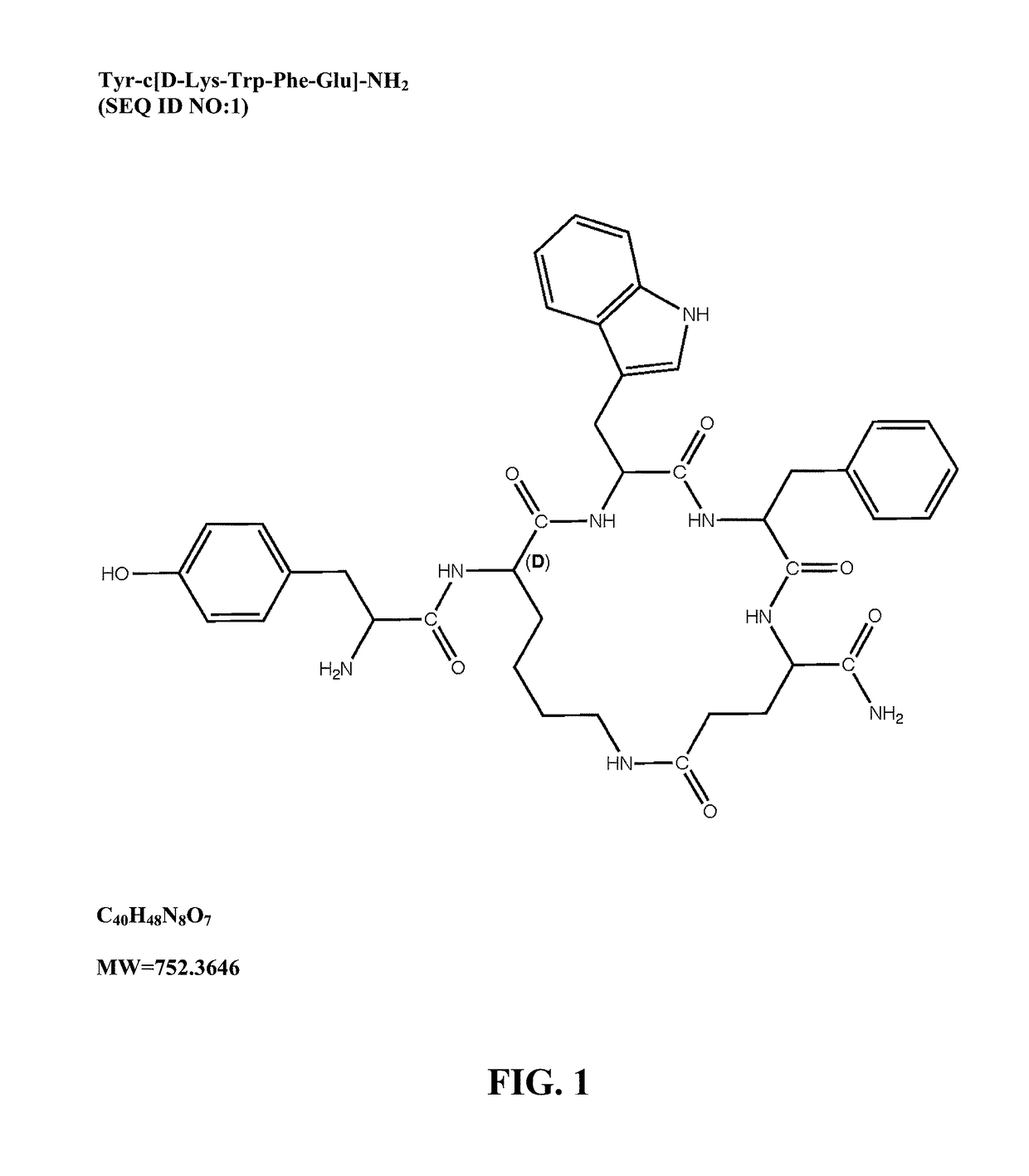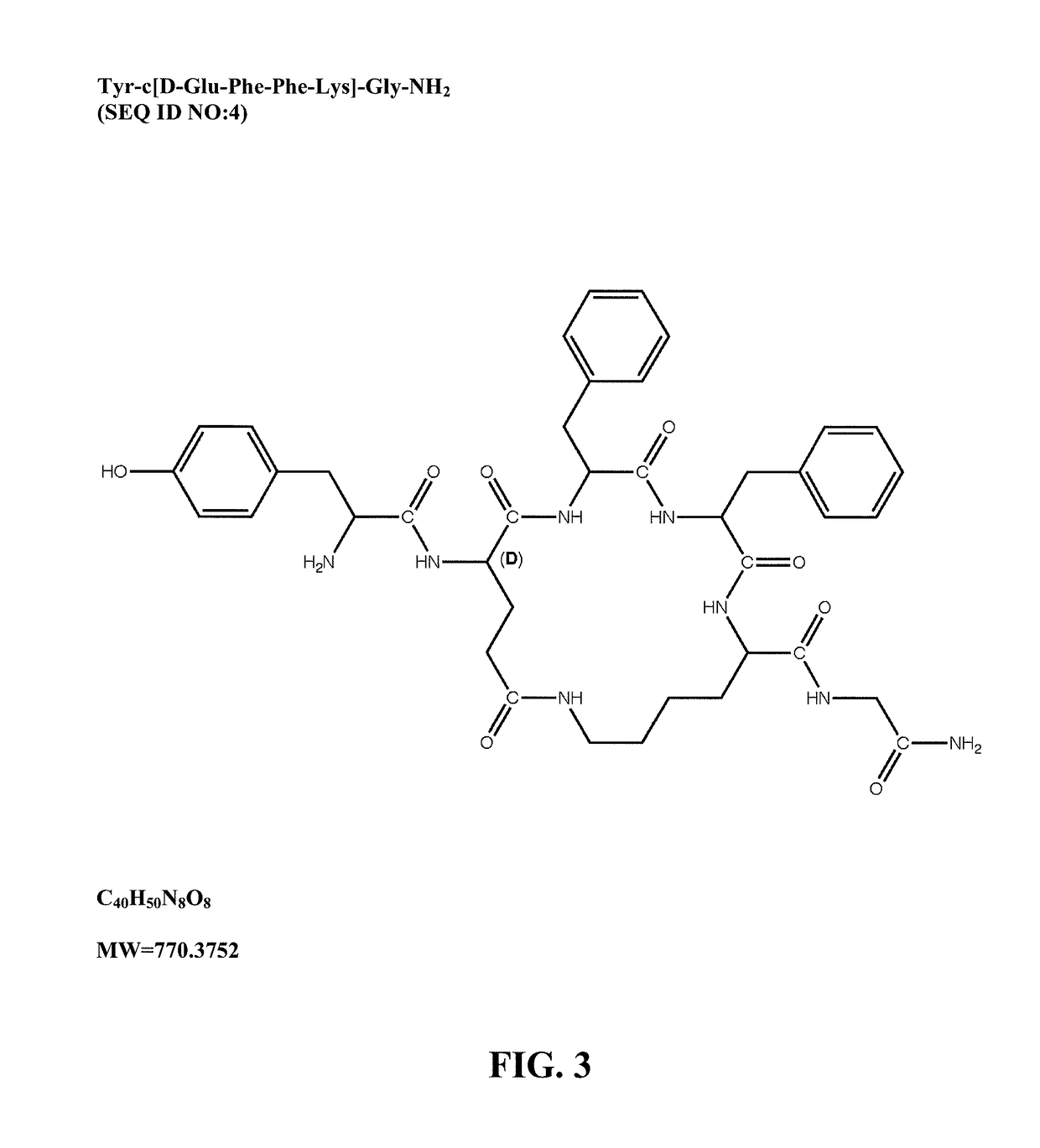Mu opioid receptor agonist analogs of the endomorphins
a technology of opioid receptor and endomorphin, which is applied in the field of peptide agonists, can solve the problems of increasing the dosage of effective pain relief and unsatisfactory tolerance to chronic opioid administration, and achieves the effects of prolonging antinociception, improving safety profile, and low side effects
- Summary
- Abstract
- Description
- Claims
- Application Information
AI Technical Summary
Benefits of technology
Problems solved by technology
Method used
Image
Examples
example 1
nd Activation of Human Opioid Receptors
[0073]The peptides of Formula I showed surprisingly high affinity (subnanomolar) for the human mu opioid receptor with selective binding relative to the delta and kappa opioid receptors. The compounds were tested in standard binding assays using 3H-DAMGO (tritiated [D-Ala2, N-Me-Phe4, Gly-ol]-enkephalin; CAS #78123-71-4), 3H-DPDPE (CAS#88373-73-3), and 3H-U69593 (CAS#96744-75-1) to label mu, delta and kappa receptors, respectively, in membranes from CHO cells expressing human cloned receptors. As shown in Table 2, endomorphin-1 (EM1, SEQ ID NO:8) and endomorphin-2 (EM2, SEQ ID NO:9) are the most selective endogenous mu agonists previously reported. Analogs based on these natural opioids show greater affinity for the mu receptor, albeit with less selectivity. Tetrapeptide endomorphin analogs described earlier (U.S. Pat. No. 5,885,958; ck1, Tyr-c[D-Lys-Trp-Phe] (SEQ ID NO:10); ck2, Tyr-c[D-Lys-Phe-Phe] (SEQ ID NO:11)) are also shown. Peptides of ...
example 2
Analgesia of Greater Duration, but with Reduced Respiratory Depression, Relative to Morphine after Intravenous Administration
[0079]Respiratory depression is a major safety issue in the use of opioids. An opioid providing analgesia as effective as that produced by morphine, but with less respiratory depression, would be a major advance for the safe use of opioid analgesics. Effectiveness after systemic administration, such as intravenous (i.v.) injection, is unusual for peptide-based compounds, and would be critical for the clinical utility thereof. Two peptides (Compounds 1 and 2) were tested for their effects on respiration (minute ventilation) and duration of antinociception relative to morphine. Rats with indwelling jugular catheters were placed in a BUXCO whole body plethysmograph apparatus for determining multiple respiratory parameters. For 20 minutes following i.v. injection of vehicle (saline), baseline minute ventilation was determined. Animals were then injected with morph...
example 3
Analgesia of Greater Duration than Morphine with Reduced Impairment of Neuromotor Coordination and Cognitive Function
[0081]Neuromotor and cognitive impairment are characteristics of opioids that are of particular importance in two populations, i.e., military combat troops, where escape from immediate danger can require unimpaired motor and cognitive skills, and the elderly, where these impairments can exacerbate compromised function including impaired balance, which can lead to increased risk of fractures.
PUM
| Property | Measurement | Unit |
|---|---|---|
| flow rate | aaaaa | aaaaa |
| flow rate | aaaaa | aaaaa |
| pH | aaaaa | aaaaa |
Abstract
Description
Claims
Application Information
 Login to View More
Login to View More - R&D
- Intellectual Property
- Life Sciences
- Materials
- Tech Scout
- Unparalleled Data Quality
- Higher Quality Content
- 60% Fewer Hallucinations
Browse by: Latest US Patents, China's latest patents, Technical Efficacy Thesaurus, Application Domain, Technology Topic, Popular Technical Reports.
© 2025 PatSnap. All rights reserved.Legal|Privacy policy|Modern Slavery Act Transparency Statement|Sitemap|About US| Contact US: help@patsnap.com



